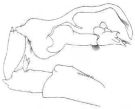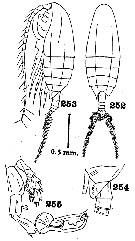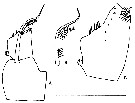|
|
 |
|
Calanoida ( Order ) |
|
|
|
Calanoidea ( Superfamily ) |
|
|
|
Calanidae ( Family ) |
|
|
|
Cosmocalanus ( Genus ) |
|
|
| |
Cosmocalanus caroli (Giesbrecht, 1888) (F, M) | |
| | | | | | | Syn.: | Calanus caroli Giesbrecht, 1888; 1892 (p.91, 127, figs.M) ; Giesbrecht & Schmeil, 1898 (p.17);
Calanus caroli (M): Wolfenden, 1905 (p.994, Rem., no F); Carl, 1907 (p.16);
Undinula darwini caroli : Sewell, 1914 a (p.198, Rem.); Vervoort, 1946 (p.78, 80); Marques, 1982 (p.751);
Undinula caroli : A. Scott, 1909 (p.18, Rem.); Sewell, 1912 (p.353, 356: Rem.); Wilson, 1942 a (p.210); Vervoort, 1946 (p.78, 81); Sewell, 1948 (p.390, 402, 404, 407); C.B. Wilson, 1950 (p.348, figs.F,M); Fagetti, 1962 (p.8); De Decker & Mombeck, 1964 (p.14);
Undinula caroli plumulosus Sewell, 1912 (p.353, 357: Rem.); Silas (p.644) | | | | Ref.: | | | Bradford & Jillett, 1974 (p.6, 13: Rem.); Fleminger, 1985 (p.276, 285, Table 4, Rem.: A1); Bradford, 1988 (p.74, 76, Rem.); Bradford-Grieve, 1994 (p.38, Rem. M); Conway & al., 2003 (p.146, fig.M, Rem); Fornshell & Ferrari, 2014 (p.109, fig.5: Vo, Vaupel Klein's organ) |  issued from : W. Giesbrecht in Fauna Flora Golf. Neapel, 1892, 19. [Taf.8, Fig.36]. Male: 36, right P5.
|
 issued from : D.V.P. Conway, R.G. White, J. Hugues-Dit-Ciles, C.P. Gallienne & D.B. Robins in Marine Biological Association U.K., Occasional Publication No 15, 2003, Version 1. [p.146]. After Wolfenden (1906). Male: terminal portion of left P5.
|
 Issued from : C.B. Wilson in U.S. natn. Mus., Bull. 100, 14 (4), 1950. [Pl. 19, figs.252-255]. As Undinula caroli. Female (with doubt): 252-253, habitus (dorsal and lateral, respectively); 254, last thoracic segment and first three abdominal segments. Posterior corners of the last thoracic segment asymmetrical, the one of the left reaching the distal margin of the genital segment, closely appressed to the latter, and smoothly rounded at its tip, the one on the right not reaching the center of the genital segment and inclined outward away from it. The urosome is the same width throughout, the anal segment fully as wide as the genital segment. The latter is as thick dorsoventrally as it is long and has no dorsal posterior spine. The short setae on each caudal ramus are less than 1/6 as long as the longest one Male: 255, P5.
|
 Issued from : J.A. Fornshell & F.D. Ferrari in Crustaceana, 2014, 87 (1). [p.109, Fig.1, A-C]. Von Vaupel Klein's organ on right endopodal segment 1 and right basal seta of P1. A, anterior, distal up; B, right basal seta; C, proximal endopodal segment (showing denticles and pores, ventral seta noted) Scale line; short = 25 µm; long = 95 µm. The Von Vaupel Klein organ is an association (srtucture) of the distal seta from basis and the proximal endopodal segment of P1. This structure shows significant variability among many gymnoplean copepods, in the shape of the distodorsal corner of the proximal endopodal segment, presence and location of denticles on the anterior face of the segment, presence and size of denticles along the distal margin of the segment , number of pores on the segment, shape of the seta that originates on the basis, and the morphology of the basis at the origin of the seta. The function of this complex structure is not known.
| | | | | Compl. Ref.: | | | Chen Y.-Q., 1986 (p.205, fig.8, Table 1: mean percentage combined with C. darwini). | | | | NZ: | 10 | | |
|
Distribution map of Cosmocalanus caroli by geographical zones
|
| | | | | | | | | | Loc: | | | South Africa (E), Atlant. (W tropical), Brazil, Indian (Maldive Is., G. of Mannar, Madagascar, Bay of Bengal), Indonesia-Malaysia, Ambon Bay (Baie d'Amboine); Philippines, China Seas, Japan, Pacif. (tropical), Fiji Is., Hawaii, off California, off Colombia, Galapagos, off Chile | | | | N: | 11 | | | | Lg.: | | | (28) M: 1,7-1,5; M: 1,85-1,65; (47) M: 1,85-1,65; (332) F: 2,14-1,97; M: 1,84-1,68; {F: 1,97-2,14; M: 1,50-1,85} | | | | Rem.: | After C.B. Wilson (1950) there has always been difficulty in separating this form from Undinula darwini, and the two forms are regarded as the same species by some authors. A. Scott (1909) fully established the two males are separate species, but was unable to separate the females. According to Sewell (1914 a, p.198-200) this species is only a variety from U. darwini, after a careful study, it appears that the sole appreciable difference lies in the structure of the P5 male.
The female, figured by C.B. Wilson, is not considered as valid. For Bradford & Jillett (1974, p.13) the separate status of C. caroli is in some doubt (see Sewell, 1929, p.46).
See Cosmocalanus darwini the distribution combined with C. caroli in Y.-Q. Chen, (1986) during the Krill Expedition: figs.1, 8, 12, 13).
See in DVP Conway & al., 2003 (version 1) | | | Last update : 04/12/2020 | |
|
|
 Any use of this site for a publication will be mentioned with the following reference : Any use of this site for a publication will be mentioned with the following reference :
Razouls C., Desreumaux N., Kouwenberg J. and de Bovée F., 2005-2025. - Biodiversity of Marine Planktonic Copepods (morphology, geographical distribution and biological data). Sorbonne University, CNRS. Available at http://copepodes.obs-banyuls.fr/en [Accessed October 20, 2025] © copyright 2005-2025 Sorbonne University, CNRS
|
|
 |
 |







